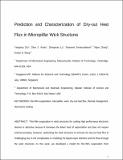Prediction and Characterization of Dry-out Heat Flux in Micropillar Wick Structures
Author(s)
Zhang, Tiejun; Wang, Evelyn; Zhu, Yangying; Antao, Dion Savio; Lu, Zhengmao; Somasundaram, Sivanand; ... Show more Show less
DownloadWang_Prediction and SI.pdf (2.150Mb)
PUBLISHER_POLICY
Publisher Policy
Article is made available in accordance with the publisher's policy and may be subject to US copyright law. Please refer to the publisher's site for terms of use.
Terms of use
Metadata
Show full item recordAbstract
Thin-film evaporation in wick structures for cooling high-performance electronic devices is attractive because it harnesses the latent heat of vaporization and does not require external pumping. However, optimizing the wick structures to increase the dry-out heat flux is challenging due to the complexities in modeling the liquid–vapor interface and the flow through the wick structures. In this work, we developed a model for thin-film evaporation from micropillar array wick structures and validated the model with experiments. The model numerically simulates liquid velocity, pressure, and meniscus curvature along the wicking direction by conservation of mass, momentum, and energy based on a finite volume approach. Specifically, the three-dimensional meniscus shape, which varies along the wicking direction with the local liquid pressure, is accurately captured by a force balance using the Young–Laplace equation. The dry-out condition is determined when the minimum contact angle on the pillar surface reaches the receding contact angle as the applied heat flux increases. With this model, we predict the dry-out heat flux on various micropillar structure geometries (diameter, pitch, and height) in the length scale range of 1–100 μm and discuss the optimal geometries to maximize the dry-out heat flux. We also performed detailed experiments to validate the model predictions, which show good agreement. This work provides insights into the role of surface structures in thin-film evaporation and offers important design guidelines for enhanced thermal management of high-performance electronic devices.
Date issued
2016-01Department
Massachusetts Institute of Technology. Department of Mechanical Engineering; Singapore-MIT Alliance in Research and Technology (SMART)Journal
Langmuir
Publisher
American Chemical Society (ACS)
Citation
Zhu, Yangying, Antao, Dion S., Lu, Zhengmao, Somasundaram, Sivanand, Zhang, Tiejun, and Wang, Evelyn N. “Prediction and Characterization of Dry-Out Heat Flux in Micropillar Wick Structures.” Langmuir 32, no. 7 (February 23, 2016): 1920–1927. Copyright © 2016 American Chemical Society
Version: Author's final manuscript
ISSN
0743-7463
1520-5827